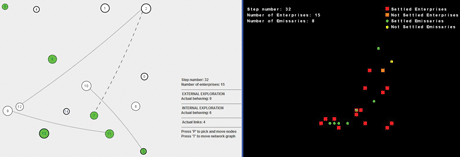by Marco Remondino and Marco Pironti
We apply computational modelling and simulation to enterprise economics and the underlying network dynamics. Here, we briefly describe a comprehensive framework.
At the e-Business L@B at the University of Turin, Italy, we are developing a computational method based on iterative agent-based simulation to analyse patterns and trends in enterprise clusters. Clustering is definable as the tendency of vertically and/or horizontally integrated firms in related lines of business to concentrate geographically, or, to a more general extent, virtually. Our goal is to create a comprehensive framework that can be used as a tool to study the dynamics of network and cluster formation and modification, when specific events occur. The aim is to be able to explore the qualitative and quantitative results deriving from the application of different strategies and different exogenous parameters (such as infrastructure quality, market complexity, the introduction of technological innovation, market shocks etc). Our model is at an advanced stage of development, but at present employs reactive agents: future plans include cognitive agents and real-world case analysis.
The development of a firm depends on its ability to expand its capabilities and resources and introduce its products into the market. Two main kinds of exploratory strategy are involved when developing new skills. The first is internally focused: firms can try to develop new competence through research and development activities. Alternatively, externally focused firms may look for partners with whom they can create links and exchange skills. The results will depend on the strategy employed, and this will have an impact on the topology of the enterprise's network.
Our model proposes three categories of agent: the enterprises, the emissaries and the environment (E³). We introduce the 'heat' metaphor to represent the advantage of an enterprise having competence. Enterprises are rewarded with a quantum of heat for every competence. If the competence is internal (ie, developed by the enterprise and not outsourced) this value is higher. The goal of each enterprise is to remain above a certain heat threshold: below this it will cease activity and disappear from the grid. It achieves this by increasing its competence, both through internal and external exploration.
In the model, the environment is metaphorically represented by a lattice with dimensions n*m and each cell of this grid is assigned a heat value. A set of enterprises is uniformly distributed in the environment. Each enterprise can use its own emissary, also scattered in the environment; these represent probes that are able to move around and report information to the parent enterprise during an external exploration phase. Each enterprise is represented by a vector whose length defines the complexity of the industry in which the enterprise operates. This vector metaphorically defines the competences possessed (both internal and outsourced). Each element C1 of the vector is a Boolean variable (where 1 means that the lth competence is possessed, while 0 means that it is not).
At each step, the cells are updated to reflect the heat produced by the enterprises according to the competences possessed and the dispersion effect managed by the environment itself. The heat of each enterprise is a function of the competences it possesses and hence of its previous behaviour (ie, its success or otherwise in creating new competences). When idle, an enterprise can decide, at each step, which strategy to choose (externally or internally explorative). Each strategy will take several steps to complete, during which the enterprise cannot carry out any other action. In addition to the physiologically scattered heat, the enterprise consumes additional energy (used by the emissary, during external exploration, or by the research and development process, during internal exploration).
If a given action is successful, the end of a phase of internal or external exploration will see the enterprise possess a new competence. An action is unsuccessful if, after several steps of research and development (internal exploration) or external searching to find a partner (through the emissary), nothing new is found and the lth competence remains set to zero. While internal competences are rewarded more than external ones, they are more expensive and difficult to produce. However, internal exploration is important, since it also permits the exchange of innovative competences during the external exploration phase, with a link being created every time at least one competence is exchanged between two enterprises. At each time-step, the set of links connecting enterprises is updated according to the competences exchanged among the enterprises.

As a result, the model defines the dynamics of link creation among enterprises. Many parameters are definable by the user at the beginning of the simulation; the framework is comprehensive and still under development. At present, the agents are reactive or stochastic, meaning their behaviour is determined by predefined rules based on the stimulus-reaction paradigm, or by a probability distribution, but we are developing cognitive strategies for them. In particular, agents will act realistically, by considering past data through a trial and error technique based on reinforcement learning. In order to simulate as far as possible the behaviour of humans in the real world, the agents will not be totally rational; they will have an internal bias that will affect the way they cognitively form their own actions for the next step.
Link:
http://e-lab.di.unito.it/
Please contact:
Marco Remondino
University of Turin
E-mail: remond![]() di.unito.it
di.unito.it










